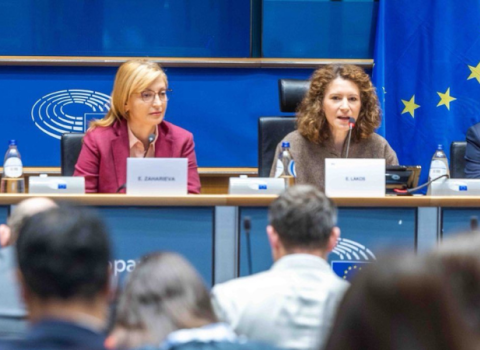GE and its venture capital partners have announced a collective investment of $55 million in power grid technology companies as part of the $200 million GE ecomagination Challenge, selecting 12 start-ups, emerging and established companies and university ideas for investment, in fields including energy storage and management, and services for charging electric vehicles. GE expects these and related fields to grow to $20 billion markets by 2015.
At the same time, GE unveiled five winners of its Innovation Award, who will receive $100,000 each for the further development of earlier-stage technologies to help them towards market. They were selected by an independent panel of judges including challenge advisor, Wired magazine editor Chris Anderson, GE executives and leading academics and technologists. Videos of the winners are available at http://www.ecomagination.com/announcements.
In testament to the level of interest and the amount of technology looking for backing and help to commercialise, almost 4,000 ideas were submitted from 150 countries over the ten weeks the competition was open.
Two of GE’s venture capital partners, Foundation Capital and RockPort Capital Partners, have agreed to co-invest in two deals, in what is the first of several rounds of innovation funding planned by GE and its VC partners as part of ecomagination, which was set up by GE in a bid to accelerate the development and deployment of power grid technology through open collaboration.
“The ecomagination Challenge has delivered on our commitment with partners to drive innovation and investment through collaborative action,” said GE Chairman and CEO Jeff Immelt. “We are working with these new partners to accelerate the development and deployment of these concepts on a scale that will help drive a cleaner, more efficient and economically viable grid.”
The partnerships formed represent a new way of doing business at GE as the company expands into the growing power grid market.
GE’s venture capital partners believe this has proved an important channel to tapping grid-related technologies worldwide. Steve Vassallo Foundation Capital General Partner said it is a “powerful approach” to discovering and developing future energy technologies. “Individuals, start-ups and established companies from around the world submitted many promising ideas to remake the world’s power grid, and we see great potential in our joint investment with GE to help Silicon Valley start-up Sentient Energy optimise capacity and reliability in the smart grid,” Vassallo said.
Similarly, Chuck McDermott, general partner, RockPort Capital, believes the sheer number of ideas and connections spawned by the ecomagination Challenge demonstrate the power of collaboration in solving energy problems. “It provided immense value to the Challenge entrants who discovered complementary solutions and made connections with people who can help advance their technologies. Our investment with GE in SustainX's energy storage technology proves that together we can create synergies to bring important clean technologies to market.”
The ecomagination challenge winners
GE is now actively negotiating investments and other commercial agreements with the 12 companies and academic partners below, including two co-investments with venture capital partners.
1. ClimateWell, Stockholm, Sweden (Efficient Appliances)
ClimateWell’s energy-efficient cooling and heating systems run on solar-powered hot water rather than electricity, maximising energy efficiency. This technology translates into a significant reduction of power consumption and carbon emissions. While initially targeting operations like hospitals or commercial buildings, GE is working with ClimateWell on deploying this technology in additional markets already served through GE’s appliances business.
2. Consert, Raleigh, NC (Energy Management Systems and Software)
Consert’s demand side energy management solution empowers utilities, municipalities and co-ops to manage load curtailment, increase operations efficiency and act as a virtual power plant. Consert’s technology complements GE Digital Energy’s existing solutions to meet the unique needs of these market segments.
3. FMC-Tech, Ltd., Shannon, Ireland (Intelligent Sensor Technologies)
The power line monitoring system for medium voltage networks serves as a nervous system for the smart grid and has applications for GE’s Smart Grid Delivery Optimisation. It integrates overhead line sensing, data storage, and wireless communication to a local controller to detect and locate faults in the smart grid and manage distribution communications, providing a platform for the present and future needs of the network.
4. The Fu Foundation School for Engineering and Applied Science, Columbia University, New York, NY (EV Charging Stations)
A new collaboration with GE, Columbia Engineering, FedEx Express, and Con Edison to enable the conversion from hydrocarbon to electric delivery vehicles in New York City. Columbia Engineering’s technology, developed by its Center for Computational Learning Systems, manages load and delivery and links electrical vehicle charging stations to the utility’s electric distribution management system in real-time. FedEx is providing and operating the all-electric vehicles that the collaborative team will study. In addition to providing funding, GE will supply expertise from its Digital Energy division and GE’s Global Research Center to support this programme.
5. JouleX, Atlanta, GA (Energy Management Systems and Software)
JouleX provides a single, network-based, energy-management solution. The JouleX Energy Manager monitors, analyses and automatically adjusts the energy usage of a network’s connected devices and systems. It has the potential to reduce energy consumption by 30-60 percent. It will enhance existing GE applications, which help customers reduce energy consumption in their data centres. In addition, the technology will enhance Demand Response Management System capabilities in GE’s Digital Energy business.
6. OPOWER, Arlington, VA (Energy Management Systems and Software)
OPOWER integrates consumer demographics, energy consumption data and behavioural analytics to encourage households to make intelligent choices about power consumption. The average user reduces consumption by about 2.5 percent per month. With GE’s global work in Smart Metering and Automatic Metering Infrastructures, OPOWER can help utilities secure buy-in from consumers and public utility commissions.
7. Scientific Conservation, San Francisco, CA (Energy Management Systems and Software)
This platform monitors and manages energy drift in commercial buildings through predictive maintenance of core energy systems: heating, ventilation, air conditioning, refrigeration, lighting, controls and renewable sources. Using its diagnostics, it typically improves efficiency covering the cost of installation in less than two years. The technology has applications for GE’s Intelligent Platforms building management software business and provides conservation opportunities for GE’s real estate portfolio and GE buildings.
8. SecureRF Corporation, Westport, CT (Utility Security)
SecureRF provides security solutions that address lower-powered embedded devices that will be used throughout the Smart Grid. Its Algebraic Eraser is a public-key cryptography method designed for resource-constrained devices like meters and sensors. GE’s Digital Energy business can draw on this security technology for the smart grid to help utility customers alleviate consumer privacy and data security concerns.
9. Sentient Energy, Burlingame, CA (Intelligent Sensor Technologies)
Sentient develops advanced grid monitoring solutions that consist of modular intelligent monitoring devices and software applications, enabling cost-effective distribution automation. It improves fault location, cause analysis and remediation, grid capacity management, and utility workforce utilisation, presenting integration and partnership opportunities for GE Energy’s Digital Energy offerings.
10. Soladigm, Milpitas, CA (Building Efficiency)
This window technology electronically switches glass from clear to tinted, enabling control of heat and glare. It can reduce energy usage for heating, ventilation and air conditioning (HVAC) systems by 25 percent and reduce the HVAC peak load by 30 percent, an important tool to level demand for the future smart grid infrastructure. With GE’s green homes and green hospitals ecomagination programmes, its zero energy home programme and other energy efficiency initiatives, there are multiple paths for commercial relationships with the technology.
11. SustainX, West Lebanon, NH (Energy Storage)
This technology provides isothermal, compressed-air energy storage technology to enable cost effective, grid-scale energy storage. SustainX’s approach has the potential to be less than half the cost of traditional compressed-air energy storage. The technology presents opportunities for collaboration with GE’s Global Research Center and commercial partnership opportunities with GE Energy to commercialise energy storage applications and to enable a higher percentage of renewable power generation in markets like Europe.
12. SynapSense Corporation, Folsom, CA (Data Centre Services)
Using a robust wireless sensor network, SynapSense’s solutions measure and manage the environmental conditions and power usage throughout data centres, resulting in a 10 per cent reduction in overall energy consumption for typical, enterprise-class data centres. The technology offers commercial relationship opportunities with GE’s Digital Energy business and its Intelligent Platforms business with its visualization and energy management offerings.
Per Olofsson, CEO of ClimateWell said GE's ecomagination Challenge offered his company an unprecedented way to find a partner to help us get our product to market faster. “We knew our technology would be a great fit. It’s an innovative, cost-effective way to heat and cool buildings while putting less stress on the grid. This unique opportunity for collaboration with GE and its VC partners gives us the jump-start we need to help bring ClimateWell’s technology to scale faster and reach new markets.”
Innovation award winners also announced
Meanwhile, the innovation award selected five winning ideas: a lightweight inflatable wind turbine; a technology that instantly de-ices wind turbine blades so they never slow or shut down; an intelligent water meter that can generate its own power; a cyber-secure network infrastructure that allows two-way communications grid monitoring and substation automation from wind and solar farms; and a technology that solves short-circuiting and outages from overloaded electric grids by enabling precise control over their flow and power.
1. Capstone Metering: Intelligent Water Meters – Carrollton, Texas - Capstone Metering applies remote communications technology to the century-old water meter. The company’s IntelliH2O is self-powered and delivers real-time water system management, which helps conserve water and eliminates the need for manual meter-readings (http://www.capstonemetering.com).
2. ElectricRoute: Secure Communications Network for the Electric Grid, Salem and Hollis, New Hampshire - Recognising the substation’s unique location in the electric grid, ElectricRoute created a communications gateway point for transmission and distribution systems. Its cyber-secure, communications network infrastructure eliminates duplicate sensors and thousands of copper lines running inside the substation.
3. GridON: Controlling Power Quality in Electric Grids, Givatayim, Israel - GridON has created a fault-current-limiter to protect the electric grid from disruptions and power outages, increasing the grid’s reliability and enabling load growth and generation expansion from alternative energy sources. This technology was developed in collaboration with Bar-Ilan University and Ricor Ltd (http://www.gridonsystems.com).
4. IceCode: Wind Turbine Blade Anti-Icing and De-Icing, West Lebanon, NH - Seeking to break one of nature’s strongest bonds, IceCode’s technology removes ice by using high-power pulses to apply heat from the inside out. Employing this technology for wind turbines substantially reduces the amount of energy used for de-icing and eliminates downtime for ice removal and inspection. Developed in collaboration with Dartmouth College (http://www.icecode.com).
5. WinFlex: Inflatable Wind Turbines, Kiryat Yam, Israel - WinFlex produces rotors for wind turbines from light, flexible and inexpensive cloth sheets made out of composite materials. This flexible rotor design reduces installation costs by at least fifty percent and shortens the return on investment to three-four years, without subsidies (http://winflex.co.il/).
For additional details of the Challenge, visit http://ecomagination.com/challenge.





 A unique international forum for public research organisations and companies to connect their external engagement with strategic interests around their R&D system.
A unique international forum for public research organisations and companies to connect their external engagement with strategic interests around their R&D system.